Replaces
2001 Ford Expedition Rear Wheel Drive Front 13 Piece Steering & Suspension Kit TRQ PSA59262
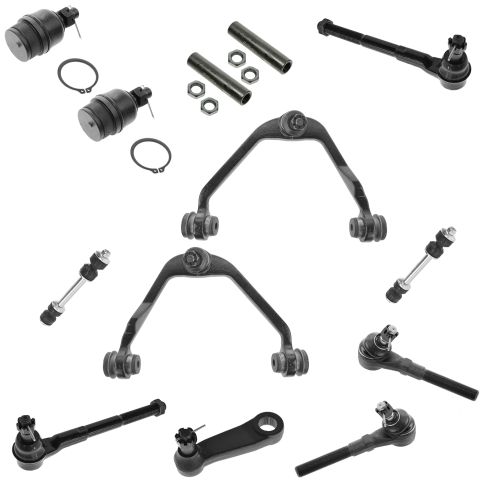


PSA59262
In Stock
This part doesn’t fit a . Select from parts that fit.
Specify your vehicle's year, make and model to guarantee fit.
Orders must be placed by 2pm ET

You may also like
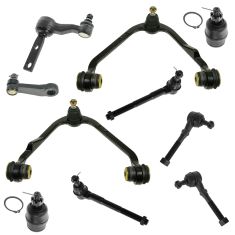
10 Piece Steering & Suspension Kit
$189.95
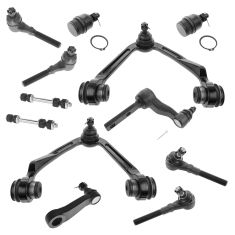
12 Piece Steering & Suspension Kit
$189.95
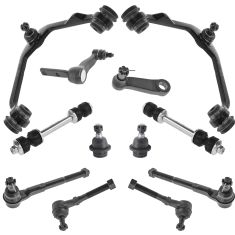
12 Piece Steering & Suspension Kit
$199.95
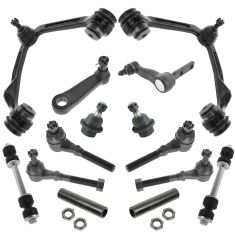
14 Piece Steering & Suspension Kit
$204.95
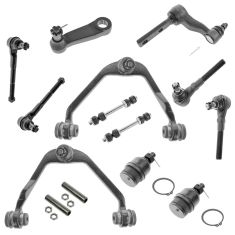
14 Piece Steering & Suspension Kit
$214.95
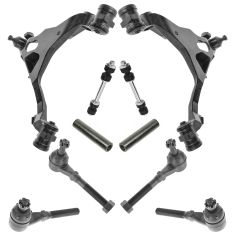
10 Piece Steering & Suspension Kit
$319.95
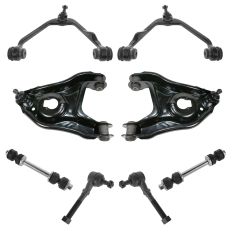
8 Piece Steering & Suspension Kit
$334.95
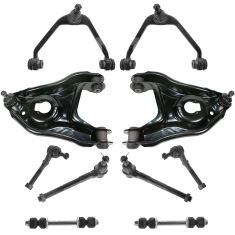
10 Piece Steering & Suspension Kit
$379.95
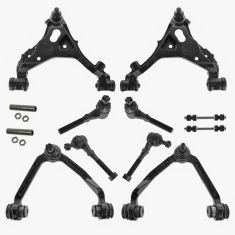
12 Piece Steering & Suspension Kit
$409.95
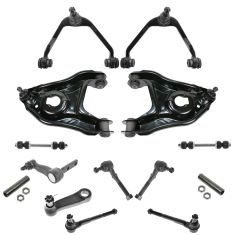
14 Piece Steering & Suspension Kit
$419.95
Part Details
- Quantity: 13 Piece
-
Kit Includes:
(2) Front Lower Ball Joints
(2) Front Upper Control Arms with Ball Joints
(2) Front Outer Tie Rods
(2) Front Sway Bar Links
(2) Front Inner Tie Rods
(1) Pitman Arm
(2) Front Tie Rod Adjusting Sleeves
Specification
- Rear Wheel Drive
- Front
TRQ suspension kits are manufactured using premium raw materials and coatings for extended service life. Each TRQ suspension component is designed to be a direct, maintenance-free replacement to the stock unit. To extend the life of your steering and suspension components, TRQ recommends replacing components in pairs, sets, or kits. All products are fit and road-tested in our Massachusetts R&D facility to ensure we deliver on our promise of Trusted Reliable Quality.
Product Features
Install Tip: When replacing steering components, have a professional alignment performed afterwards. This ensures proper tracking and even tire wear.
Our steering and suspension components are pre-greased and sealed for long life and do not require the extra maintenance typically required by greaseable versions.
Item Condition:
New
Attention California Customers:
![]() WARNING: This product can expose you to chemicals including Lead and Lead Compounds, which are known to the State of California to cause cancer, and birth defects or other reproductive harm. For more information, go to www.P65Warnings.ca.gov.
WARNING: This product can expose you to chemicals including Lead and Lead Compounds, which are known to the State of California to cause cancer, and birth defects or other reproductive harm. For more information, go to www.P65Warnings.ca.gov.
Lifetime Warranty
This item is backed by our limited lifetime warranty. In the event that this item should fail due to manufacturing defects during intended use, we will replace the part free of charge. This warranty covers the cost of the part only.
FREE Shipping is standard on orders shipped to the lower 48 States (Contiguous United States). Standard shipping charges apply to Hawaii and Alaska.
Shipping is not available to a P.O. Box, APO/FPO/DPO addresses, US Territories, or Canada for this item.
Expedited is available on checkout to the United States, excluding Alaska, Hawaii.
Final shipping costs are available at checkout.






Created on:
Tools used
- Turn the wheels for access to the stabilizer link. Spray the stabilizer with penetrating oil. 9/16� socket on the bottom and a 15mm socket on the top. Loosen the stabilizer link. Use a hammer and punch to push the link out. Use vice grips if needed.
- Push the link up into place. Put the link together in this order: Bushing on the bottom of the control arm. Bushing above the control arm. Washer Shaft Washer Bushing Bushing Washer Nut. Tighten the stabilizer to 15-17ft/lbs.
Brought to you by 1AAuto.com, your source for quality replacement parts and the best service on the internet.
In this video I'm going to show you how to replace the stabilize links on this 97 expedition, same as many Ford and Lincoln trucks and SUVs. When these go bad, sometimes they break out right and just kind of fall out and then your truck is going to sway back and forth more. Also you may here a clunking when you go over bumps and that clunking actually goes away when you're going over bumps but you're turning, because it's putting some pressure on the Lincoln and not making noise.
Tools you'll need, I put jack and jack stands on here but you can actually accomplish this with the vehicle on the ground. Obviously it's a lot easier to film it with jack and jack stands but you will need 9/16 and 14mm sockets. The 19mm socket will be if you're taking the lug nuts off. Ratchet and extensions. You'll need a hummer and a punch, vise-grip or locking pliers and penetrating oil. Actually those last four things are only if yours is rusted on there like ours was.
Okay, to film it, it's a lot easier to take the wheel off. This is a repair you can do just by turning if you want to replace the right hand one you can turn your wheels all the way to the right and you can probably get in there well enough, remove the stabilizer link without jacking up the vehicle or taking the wheel off. I'm going to loosen the lug nuts here then raise and secure the vehicle and remove the tire.
Next I'm going to remove the stabilizer links. I'm going to spray the top of it with some penetrating oil and let it sit for a while. Okay this stabilizer links are sometimes difficult to get apart. You can use hand tools, they will come apart. I just chose to use a impact wrench just to make it easier. I have a 9/16 socket on the bottom and a 14mm socket on top.
Okay, use a hummer and pound down that bolt then use punch see if you can get it to go down through the sleeve, I end up actually having to use vise-grips and the wrench. Okay what I'm going to do here, I'm going to set up vise-grips on to this shaft, more tighter here. Here I'm going to install the sway bar link. I've already put a new link on the other side and just started the nut on it. The bushing always go towards the middle. We got bushing on the bottom going up to the control arm, bushing above that. My shaft goes on there and then the washer and the bushing. Okay push them down and in, and make sure that bushing is centered in there. Stabilizer bar. Now bushing and washer, and then my bolt or nut.
Okay, now you want to use the jack put pressure on the suspension and then tighten up the stabilizer to 15, to 17 foot pounds. You can put your tire back on and start each lug nut one by one make sure you don't cross-thread them. Tighten them down preliminarily. Put the lug nuts to 100 foot pounds using a star pattern.
We hope this helps you out. Brought to you by www.1AAuto.com your source for quality replacement parts and the best service on the internet. Please feel free to call us toll free 888-844-3393. We're the company that's here for you on the internet and in person.
Tools used
- Set up the ball joint in the ball joint press. Get the top of the ball joint flush with the top of the control arm. Readjust the press, taking the rubber boot off and get the control arm the rest of the way in. Replace the rubber boot. Lock it into place with a snap ring. If you have snap ring pliers, this is much easier but you can do it without them.
- Position the ball joint pointing outward and work the steering knuckle onto it. Lower the jack stand from the control arm. Thread the nut onto the ball joint. Put the grease fitting on the ball joint.
- Get the axle into the hub and transmission. Torque the bolts to 60 foot pounds, using a star pattern to secure the axle evenly.
- Torque the ball joint nut to 98 foot pounds and secure with a cotter pin. Fill the lower ball joint grease fitting with grease using a grease gun. Torque the tie rod nut to 60 ft lbs and secure with a cotter pin.
- Thread the washers and bushings onto the link. Jack the control arm up and tighten the stabilizer link nuts to 15-16 ft lbs. Thread the hub nut on. Lower the jack from the suspension. Retighten the torsion bar to the mark you made earlier.
- Thread the lug nuts on. Lower the vehicle. Torque the lug nuts in a star pattern to 100 ft lbs. Torque the hub nut to 220 ft lbs using your 35 mm socket. Put the retainer and cotter pin and wheel cap on. Have your alignment checked and adjusted.
Brought to you by 1AAuto.com. Your source for quality replacement parts and the best service on the Internet. Thanks for tuning in, this is Part Two of a two part series. We're going to go through reinstalling your lower ball joint on this '97 Expedition. This procedure is similar for a whole bunch of different Ford trucks and SUVs. Here's a list of tools that we used on this Expedition. If you have a different vehicle some of the sizes may differ and one thing that is not on here, you will want a grease gun to grease up the ball joint after you install it.
We've got our control arm here. We're just going to put it right on there like that. Our ball joint, our collar and then that's going to go up and in. We put our press on there. I'm going to speed it up here so we use the press to push the ball joint up and in and you do this in two steps. This first step is just going to get the top of the ball joint flush with the top of the control arm. We're going to take this boot off. Now with this ramp here on top of it. I'll fast forward here again as we use that press to push the ball joint the rest of the way up into the control arm until it's nice and tight, the bottom is nice and tight against the bottom of the control arm and then put your protective boot back on. Now you want to lock it in place with a snap ring. You can get this on without snap ring pliers, but they certainly are a help. Just get this set up.
What I'm going to do is I'm just going to thread the nut on a little bit and then use a hammer to kind of knock the ball joint outward, that helps make it easier to get the other and just keep that protective boot up on there. That's just going to allow your knuckle down on there, your knuckle up, take your jack out of the way. Lift it up on the knuckle and bolt. Okay, I'm going to speed through putting the half shaft back in. One thing I did forget to do, I do a little bit later, is now is the best time to put the grease fitting on top of the ball joint, before you put that axel in there, but put the axel in place to get it into the hub and then get it lined up on the axel and start a couple of those 13 mm bolts. Once you get all the bolts in you want to torque them to 60 foot pounds and what I do is I use a black marker.
I mark the head of them after I torque them. Then you want to kind of go to the opposite side, torque the next bolt, mark it and just keep going until they're all torqued. I'm just putting the tie rod back on. Just put the nut on there and keep it in place. Now we want to tighten the ball joint nut to 98 foot pounds and that's for this '97 Expedition. It could be different for your vehicle. Okay, I put our cotter pin through, bend it down and around. I'm going to fast forward through putting the grease fitting on top. Like I said earlier a little bit easier to do this step before you put the axel in. Then continue to fast forward as a put a grease gun onto that fitting and fill the lower ball joint with grease. Okay, I'm going to tighten my tie rod nut to 60 foot pounds. Next the cotter pin through, bend it down. Here I'm going to install this sway bar link. I've already put a new link on the other side, then just started the nut on it. Bushing, the bushings always go towards the metal.
Okay, so I've got a bushing on the bottom going up to the mount control arm and a bushing above that. Then my shaft goes on there and then the washer, then the bushing pushing down and in. Make sure the bushing is centered in the stabilizer bar unit. Now bushing and washer, then my nut. Now you'll want to use your jack to put some pressure on the suspension and then tighten up the stabilizer to 15 to 17 foot pounds. Then we'll put on our center hub nut. We're just going to tighten that preliminarily. We're not going to torque it until the wheel's back on. Now you can let your suspension back down and you want to re-tighten your torsion bar and since we marked it we can tighten it right back up to where it was before. You can put your tire back on and start each lug nut one by one. Make sure you don't cross thread them. Tighten them down preliminarily. Torque the lug nuts to a hundred foot pounds using a star pattern. Okay, now using a 35 mm socket torque your lug nut to 220 foot pounds. Put the retainer back on and then the cotter pin, then your wheel cap. We recommend you have your alignment checked and adjusted if necessary.
We hope this helps you out. Brought to you by www.1AAuto.com, your source for quality replacement parts and the best service on the Internet. Please feel free to call us toll free 888-844-3393. We're the company that's with you on the Internet and in person.
Tools used
- Pull off the center cap Loosen the lug nuts Remove the cotter pin and loosen the 35mm hub nut Loosen the seven 13mm 12-point bolts that hold the axle to the front drive Raise and secure the car Remove the wheel
- Spray the torsion bar with spray paint and loosen the torsion bar tension bolt with an 18mm bolt
- Use a pair of pliers to remove the cotter pin Remove the nut at the end of the tie rod Use a tie rod puller to separate the tie rod
- Use a 9/16 wrench to secure the bottom and a 14 mm socket to unbolt the stabilizer link Use a hammer and punch to remove the stabilizer link
- Unbolt the seven bolts, using a pry bar to keep the hub from rotating Remove the hub nut using a 35 mm socket Give the axle a tap with a hammer and pull the axle out
- Use a jack and wood plank or two to lift the control arm and relieve tension from the ball joint Unbolt the the ball joint using a breaker bar and 27mm socket Use a ball joint removal tool to pull the ball joint apart With a ball joint press, remove the ball joint completely See Part Two for reassembly
Brought to you by 1AAuto.com your source for quality replacement parts and the best service on the internet. Hi, I'm Mike Green. I'm one of the owners of 1A Auto. I want to help you save time and money repairing or maintaining your vehicle. I'm going to use my 20-plus years experience restoring and repairing cars and trucks like this to show you the correct way to install parts from 1AAuto.com. The right parts, installed correctly that's going to save you time and money. Thank you and enjoy the video.
This video is part one of a two-part series, replacing the ball joint in this '97 Expedition. In this video, we basically detail removing the old ball joint. This is the same for all the Expeditions, F150s, Explorers, a whole bunch of the Ford trucks and SUVs from this era.
Here's a list of the tools that we use on the Expedition. If you're doing a vehicle different from the Expedition, some of these sizes may differ. You will need heavy-duty tools. You're not going to want to try this with the 20-piece set Uncle Joe gave you for Christmas. This is heavy work. You'll need jack and jack stands, metric sockets 13-27 mm, standard sockets 1/2 inch to 7/8, you'll need a 35 mm socket, a 12 point 13 mm socket, ratchets extensions and a breaker bar or pipe because you will need to get some leverage on some of those bigger bolts and things, pliers, hammer, a heavy punch, ball joint removal tool, ball joint press, large flat blade screwdriver, and a paint marker or a old can of spray paint. The ball joint removal tool I'd recommend if you're going to be doing a lot of your own work. It's a pretty affordable tool to go out and get. Ball joint press might be something that you want to borrow.
Obviously, you're going to start by removing your cap. If you don't have the benefit of air tools, what you'll want to do is start with your wheel on the ground. With your wheel on the ground, there are probably three things you're going to want to do. Loosen your lug nuts. Then there's a 35 mm bolt in the center that holds the axle into the hub you're going to want to take the cotter pin and the cover off of that and loosen that 35 mm bolt. Also, go underneath and there are seven 13 mm 12 point bolts that hold your axle to your front drive. You'll want to just loosen those seven bolts. Much easier to loosen all these bolts with your tire on the ground held in place if you don't have all the tools that I have access to. You're going to want to loosen up your torsion bar. Your torsion bar is actually your spring. This is what supports the vehicle. I'm just going to take a little silver spray paint ... That way, when I back that bolt out, I'll know where it originally was.
Using an 18 mm socket and a ratchet, I'm going to loosen the torsion bar tension nut, or bolt, and you can basically pull it all the way out and then just turn it back in a few turns. You just want to loosen it up and take as much tension off the torsion bar as you can. You can see as I'm done, you can see where there's no paint on the threads, that that is how far you would want to retighten it. Now we're going to undo our tie rod end here. I'm just going to speed it up here. The cotter pin's very rusty, so first so first I break it with the pliers. Then I use a hammer and punch and just kind of keep working and breaking small pieces off until I can drive it through and out of the tie rod end. Now I'm pounding a 21 mm socket onto that nut because it was quite rusty. I just want to make sure I get a good socket that gets a good grip on it.
I've got a bar on here. Put a piece of pipe on it for some more leverage. Hopefully it comes apart. Just fast forward here as I switch over to a ratchet and remove the nut the rest of the way. Here I'm going to put a tie rod, it's a tie rod and ball joint tool, but obviously I'm using it to do a tie rod right now. By using this tool, I can assure that I can just reassemble my tie rod. I won't damage the tie rod by removing it this way. Next, I'm going to remove the stabilizer link, so I'm going to spray the top of it with some penetrating oil and let it sit for awhile. These stabilizer links are sometimes difficult to get apart. You can use hand tools. They will come apart. I just chose to use a impact wrench just to make it easier. I have a 9/16 socket on the bottom and a 14 mm socket on the top.
Use a hammer and pound down on that bolt. Then use a punch, see if you can it to go down through the sleeve. I end up actually having to use vice-grips and a wrench. Obviously, you also want to remove the other side so you can move your stabilizer bar around easily. What I'm going to do here, put set of vice-grips onto this shaft, tighter here. Now we're going to remove the half shaft of the CV axle. As I said in the beginning of the video, these are the bolts that if you don't have all the tools that I have, it might be easier to just loosen them while the vehicle's on the ground. You can see I use a big, large crowbar to hold the hub in place while I'm loosening those bolts.
You can see I spin it, loosen one of the bolts, spin it some more, loosen another bolt. If you were actually doing this with your vehicle on the ground, you'd have to probably loosen one or two of the bolts, then roll your car a little bit, put it in park, put the emergency brake on, loosen a couple more, and keep repeating that process.
Once it's unbolted, pull it down and off. I use a pair of pliers and either break off the ends or just straighten out the cotter pin and pull it out. Okay, 35 mm ... As I said in the beginning, if you don't have impact tools and this is easier with the tire on and on the ground, your other option would be to have a helper hold the brakes while you remove it.
What I do is give it one tap and just watch it, see if it moves. Actually, it moves pretty freely. You can pull your stabilizer bar up and out of the way. Pull your axle down towards the front. Then push it, lift it up, push it out. I've got the vehicle support under the frame. Then I've got my jack right under the control arm. You can see there is the bolt for the ball joint, and then there's the jack. I have a piece of the wood on there so I can easily access that ball joint bolt, as well as get a puller on there. Now I can jack it up. You can see, without that torsion bar tightened, the suspension travels here very easily.
Now I'm going to use pliers to break off and remove the cotter pin from the lower bolt. It ends up being kind of a rusty mess, so I actually use a hammer and punch and pretty much just break it away as much as possible so I can get that bolt off. Now a 27 mm socket put it on there, use a little hammer, make sure it goes all the way on. Got a breaker bar on there, actually you're going to take piece of pipe, put it on, give me some extra leverage. It's coming loose. Just one note here: It will help if you take your tie rod and put it back into the steering knuckle and just put the bolt on. That tie rod will hold things in place while you loosen that ball joint nut.
Just speed it up as I change over to my ratchet and take that bolt most of the way off. While my bolt's still on there, take my ball joint removal tool- This just, doing it this way, allows you to break it free without things falling down. Finish removing this bolt. Get your control arm on up. Pull the steering knuckle down and off.
There's a snap ring that holds the ball joint in place. You can use snap ring pliers. Mine was pretty rusty so I used a screwdriver and a hammer to just kind of pry it off and pop it off.
Now you're going to take a ball joint pulling tool, put the collar up on there. With this particular press use a 7/8 socket, put one on top there, and just tighten down the press. Traded my ratchet handle for my breaker bar. I'm going to speed it up here. What I did there was I created a whole lot of pressure by tightening it down. Then I used a hammer, gave it a good whack that kind of broke it free, and then the press just works it the rest of the way out. There's my old ball joint out.
Good a place as any to end it. Check out part two for the reassembly.
We hope this helps you out. Brought to you by www.1AAuto.com, your source for quality replacement parts and the best service on the Internet. Please feel free to call us toll-free, 888-844-3393. We're the company that's here for you on the Internet and in person.
Tools used
- Loosen the five 19mm lug nuts Raise and support the vehicle Remove the lug nuts Slide the wheel off the hub
- Apply rust penetrant to the sway bar link Attach a 14mm wrench to the top sway bar link nut Brace the wrench against the vehicle frame Turn the 14mm bolt at the bottom of the sway bar link to loosen the nut Remove the 14mm nut Tap the top of the bolt with a hammer Remove the sway bar link bolt Remove the sway bar link bushings, washers, and sleeve
- Slide a washer (dish up) onto the sway bar link bolt Slide a bushing onto the sway bar link bolt Slide the sway bar link bolt through the control arm Slide a bushing onto the sway bar link bolt Slide a washer (dish down) onto the sway bar link bolt Slide the sleeve onto the sway bar link bolt Slide a washer (dish up) onto the sway bar link bolt Slide a bushing onto the sway bar link bolt Insert the sway bar link bolt into the sway bar Slide a bushing onto the sway bar link bolt Slide a washer (dish down) onto the sway bar link bolt Thread the nut onto the sway bar link Attach a 14mm wrench to the top sway bar link nut Counterhold the sway bar link nut with the wrench Tighten the sway bar link bolt with a 14mm socket and ratchet
- Slide the wheel onto the hub Start the lug nuts Lower the vehicle to the ground Tighten the lug nuts to between 83 and 112 foot-pounds of torque in a star pattern
Hi, I'm Mike from 1A Auto. We've been selling auto parts for over 30 years. We're dedicated to delivering quality auto parts, expert customer service, fast and free shipping, all backed by our 100% satisfaction guarantee. Visit us at 1AAuto.com, your trusted source for quality auto parts.
So, when we're going to start this project, we're going to go ahead and loosen the lug nuts on the wheel. We're going to use a breaker bar with a 19 mm socket. Next, we're going to go ahead and raise and support your vehicle. You can use a jack and jack stands. In this case, here, we're using a lift to make it a little bit easier. We just go ahead and remove the lug nuts here, just by using that socket, because we already loosened those. With the lug nuts removed, we can now go ahead and remove the wheel and tire.
Right about here, we have your sway bar or anti-sway bar end link, here. Here's your sway bar. In most cases, here, you'll find these sway bar end links broken. What we're going to do is we're going to show you how to go ahead and remove this and do an installation for you. This component, here, can actually be removed and replaced with the tire still on the vehicle. We just happened to have the vehicle up in the air with the tire off so it just made it a little bit easier. This is something you can do with the tire still on there.
All right, so we're going to use a 14 mm on the head of the bolt down below, and we're going to use a 14 mm on the top. It may vary on your application. I'm going to go ahead and remove this nut here. Now, this does come off in stages. You have your main washer. You have your rubber of poly bushing. Then, obviously, you have the sway bar link here, or the sway bar itself, anti-sway bar. I'm going to try and just tap this down. This bolt will slide out through the bottom. What we don't want to lose is all these components in the middle here. We're going to show you what those do. Before we pull this out, we're going to go ahead and start pulling apart the internal pieces here.
Here is your complete anti-sway bar end link. You can actually see it just starts off with just a basic bolt. Then you have your metal collar here. You want to make sure that that slides on so that the dish part is facing upward. Then you're going to take your component here. Your bushing could be a poly or rubber bushing. Slide that down. Now, this is going to go up inside the control arm. What you want to do is sleeve the components together. What's going to happen next is your next bushing is going to go on, followed by your next dish. Now this is going to go the opposite way, so it's going to compress and squeeze against its matching component. This here is simply just a sleeve. It's not threaded. Slips right down. Your next component is that there. Slide this on, and once again we're going to sleeve the other component, which is your sway bar, your anti-sway bar. That'll slip on followed by that, and followed by the nut. That there is your complete unit. Our vehicle doesn't actually need replacement, but this is just your R & R process.
Here's the reinstallation. Going to slide this up through the bottom, and go ahead and slide your bushing down, followed by that spacer and that washer. We're going to now go ahead and put the sleeve on. It's going to be the next bushing. I'm sorry, it's actually your spacer, here, first, then the bushing. Now, you have the slide this up underneath like so. You want to push that up, push that bolt up through the middle. Now, you can see the base bolt is in.
You have your bushing, collar, sleeve, collar, bushing. The bushing and the collar right there. The last component is the nut. We're going to go ahead and get the threaded on. We're going to go ahead and tighten this up with a 14 mm. As you're tightening this here, you may be wondering, "How tight do I tighten this here?" Well, basically you want to get it so that the rubber bushing expands out to roughly the diameter of the metal washers there.
I'm going to go ahead and reinstall the tire. I'm going to go ahead and reinstall the lug nuts, here. You want to get a few threads caught on all of these, here. These lug nuts are a 19 mm. We're just going to snug these, bottom it out, bottom the wheel out to the rotor. We're going to lower the vehicle down onto its own weight, and then do a final torque. With the vehicle on the ground, we're going to do its final torque of the wheel, which is between 83 and 112 foot pounds. We're going to do it in a star pattern. I'll just double check the first one. She's all set.
Thanks for watching. Visit us at 1AAuto.com for quality auto parts, fast and free shipping, and the best customer service in the industry.
Tools used
- Loosen the five 19mm lug nuts Raise and support the vehicle Remove the lug nuts Slide the wheel off the hub
- Remove the cotter pin from the castle nut Remove the castle nut with a 13/16" wrench Strike the wheel knuckle with a hammer to loosen the tie rod end Twist the tie rod end off the inner tie rod, counting how many rotations it takes to remove
- Loosen the adjuster sleeve from the inner tie rod with a 24mm wrench Twist the adjusting sleeve off the inner tie rod
- Thread the wider diameter side of the adjusting sleeve onto the inner tie rod Tighten the sleeve up to the jam nut while holding the inner tie rod in place
- Start the tie rod end into the adjuster sleeve Turn the tie rod end in, the same number of turns it took to remove Line up the tie rod end into the wheel knuckle Fasten the castle nut onto the tie rod end Line up the castle nut with the hole in the tie rod end Feed the cotter pin through the hole Bend the cotter pin with pliers to secure it Tighten the jam nuts with a 27mm wrench
- Slide the wheel onto the hub Start the lug nuts Lower the vehicle to the ground Tighten the lug nuts to between 83 and 112 foot-pounds of torque in a star pattern
Hi, I'm Mike from 1A Auto. We've been selling auto parts for over 30 years. We're dedicated to delivering quality auto parts, expert customer service, fast and free shipping, all backed by our 100% satisfaction guarantee. Visit us at 1AAuto.com, your trusted source for quality auto parts.
So in order to start this project you want to go ahead and loosen the wheel and the lug nuts here. We're going to use a breaker bar with a 19 millimeter socket. So next we're going to go ahead and raise and support your vehicle. You can use a jack and jack stands. In this case here we're using a lift to make it a little bit easier. Just go ahead and remove the lug nuts here just by using that socket because we've already loosened those. With the lug nuts removed we can now go ahead and remove the wheel and tire.
So this right here is your outer tie rod end. We have the nut here to anchor this on. This is the castle nut. Normally you would have a cotter pin through here, but this did not have it in there. So it must have rotted or fallen out. So we're going to go ahead and remove this nut off of the outer tie rod end, and we're going to use a 13/16” wrench for this here.
So in order to remove this outer tie rod end, this actually fits into a tapered hole. What we can usually do in our driveway at home is, if you use a hammer and you strike the front here, it normally causes this to pop out. So now that we have this out, you can see that this is a tapered base, and this fits tightly into the front of the steering knuckle. So when you tighten up the castle nut, it sucks it down inside and keeps it nice and tight.
We're going to go ahead and replace the adjuster sleeve right here. We want to start by removing your outer tie rod end. Ideally, you want to count the amount of threads that this comes out on, so you have full rotation of this ball joint on your tie rod end.
Okay. We're going to use a 24 millimeter and we want to go ahead and basically unthread this off of the inner tie rod end. There we go. Now, because we're just replacing the adjuster sleeve, you can leave this jam nut right here, and when you take the new adjuster sleeve, just thread it right on up to that jam nut. There we go.
This here is the old part. This here is the new part from 1A Auto. If you notice, on the old part, we have the spot right here that has a flat section so you could put your wrench on there. Our part also has that. On the installation it is important to know that each side is a different diameter. The larger is the inner tie rod end port, and the smaller one is for the outer tie rod, so you can only put it on one way. Obviously if you have the smaller port, it just won't fit.
We're just going to go ahead and thread this on. When this threads on, you're going to notice that the wrench side is closer to the tie rod on the outer tie rod, but this here was closer to the inner. It doesn't matter. It's going to work the same exact way, it's just to give you an anchoring point for your wrench. Okay, you want to just crank that right up by hand up to that jam nut.
Now that we have the adjuster sleeve installed, because we don't actually have to replace this outer tie rod end, we can go ahead and get this installed now. In this component, we did count 31 full rotations. That means for the ball joint section facing down, a full rotation, that is one. We counted 31 of those there. In case you were installing a new outer tie rod end, you would have that count. I believe that was a 31. We'll just tighten up that jam nut by hand a little bit.
Then you're ready for your installation. Install your castle nut. You would tighten this up. Line up the castle nut with the hole in the outer tie rod end there. Use your cotter pin, feed it through, and then you're going to want to bend that over using a pair of pliers. Your adjuster sleeve may come with jam nuts. If your factory equipment is just fine, there's no need to replace them. Okay, so we're going to go ahead and tighten up these jam nuts.
All right, I'm going to go ahead and reinstall the tire. I'm going to go ahead and reinstall the lug nuts here. You want to get a few threads caught on all of these here. These lug nuts are 19 millimeters. So we're just going to snug these, bottom it out. Bottom the wheel out to the rotor. We're going to lower the vehicle down onto its own weight, and then do a final torque. With the vehicle on the ground, we're going to do a final torque of the wheel which is between 83 and 112 foot pounds. We're going to do it in a star pattern. All right, just double check the first one. She's all set.
Thanks for watching. Visit us at 1AAuto.com for quality auto parts, fast and free shipping, and the best customer service in the industry.
Tools used
- Remove the center cap. Loosen the lug nuts. Raise the vehicle. Remove the lug nuts. Remove the wheel.
- Jack up the lower control arm to support the suspension. Mark the upper bolts on the control arm with a marker to remember their alignment. Draw a line on the bolt and on to the bracket. Remove the cotter pin from the balljoint. Spray the ball join and upper bolts with penetrating oil. Us a 21mm socket on the balljoint bolt. Hammer it on. Use a breaker bar and pipe for added leverage to loosen the 21mm bolt. Don’t full remove the bolt. Loosen the other two 21mm bolts using a socket and breaker bar. Remove the nut from the balljoint and use a balljoint puller tool to separate the control arm and steering knuckle. Use a 19mm to tighten the balljoint removal tool until it pops. Remove the upper nuts and bolts. Pull the control arm free.
- Use a wire brush where the control arm goes. Put the new control arm in place. Push it down onto the balljoint and start the bolts. Reinsert the upper bolts. Line the marks up. Torque Ball joint nut to 67ft/lbs. Insert new cotter pin and use pliers to bend the end. Put a grease fitting on and pump grease into the ball joint. Raise the vehicle so all the weight is on the suspension. Torque the upper bolts to 100ft/lbs.
- Put the wheel in place. Replace the lug nuts. Lower the vehicle. Tighten the lug nuts to 100ft/lbs in a star pattern. Replace the center cap.
Brought to you by 1AAuto.com, your source for quality replacement parts and the best service on the internet. In this video, we're going to show you how to remove and replace the upper control arm on this 1997 Expedition. At 1A Auto, we sell a nice replacement upper control arm. This takes care of if you have worn out bushings as well as a worn out upper balljoint. Replacing the whole assembly will take care of both those issues. We're doing this on this Expedition, but it's also the same for a lot of different Ford and Lincoln SUVs and pickup trucks.
Tools you'll need are 19 and 21 mm sockets and that could vary depending on what vehicle you're working on, a ratchet, breaker bar, and a pipe for leverage. Some of those bolts can be a little stubborn so having some extra leverage is always good, pliers, penetrating oil, a marker, a balljoint removal tool, a hammer, as well as jack and jackstands.
We're going to start out by removing your wheel. If you don't have impact tools, start with your wheel on the ground. Loosen the lug nuts then raise and support the vehicle, then take the lug nuts off and the wheel off. Once you have the tire off, you're going to want to roll a jack underneath the lower control arm and lift up and support the suspension. Now there's basically three bolts. You've got the balljoint bolt here that you're going to remove. You have to take the cotter pin out first. Then you have two bolts up here that hold it to the frame, and one there and then obviously one right here. The bolts and washers that hold the control arm to the frame are actually what you use to align and set caster and camber. What I'm going to do is I'm going to use a marker and just make a vertical line on them so I have a good reference point to put them back together which gives you a pretty decent preliminary alignment. You will want to have your alignment checked and possibly adjusted after this repair.
What I'm going to do, I'm going to take a black marker and we'll make a line just straight up and that would I know that, that one's in there like that and then same thing over here. Make a line straight up so I know how they came out. Here, I'm using a pair of pliers and just grab in the ends of the cotter pin that have been pushed through and bent and you basically just break them off, that's usually the easiest way then you can pull it out from the other side. There's the cotter pin. I am going to get my screwdriver in here and pry that right out. I'm going to spray that with penetrating oil, also spray my other ones up top here.
Now, I'm going to take a 21mm socket and put it on that bolt. Now, I'm using a hammer just to make sure it's all in there all the way. You're going to want at least a breaker bar and get it on here. Have to reposition my socket here so that I can make sure. I'm actually going to put an extra piece of pipe on my breaker bar. It gives me even more leverage. Get it loose. Now, I could switch to the ratchet and remove it all the way. I'm just going to keep the bolt on there a little bit. I'm going to turn my attention towards these bolts here. Same thing, get our socket on there.
Breaker bar, they seemed to be coming off all right. I loosen up that one a couple of turns then turn my attention towards the rear one. Use a hammer to try and get the socket on there. The bolt or the nut is a little crusty, so I just get it that on there and then it comes part as well. Once we get that bolt or the nut to the end there like that, our hammer, make sure we can get that bolt out. Here we're just making sure that we can get the bolts loose. You don't want to take them out yet, but you do just want to make sure, give him a couple of taps and turn them with a wrench and make sure they're free.
I was pleasantly surprised even though this truck is pretty crusty and rusty, they did come free pretty easily. Now, you're going to want to remove the nut from the upper balljoint and then use a balljoint puller tool to separate the arm, the control arm and the steering knuckle. You can see here I removed that plastic around the upper balljoint then put my balljoint separator tool on and get it in position. I'm going to use this, the 19 mm and you basically just tighten it up until it pops. You see your steering knuckle comes out of the way. Now, I just remove the nuts and washers from the ends of those bolts that hold the frame.
Pull the bolts out. I just kind of put everything right on the frame next to it so I keep the same hardware with the same sides. Take my old control arm out. Use a wire brush and or a screwdriver, just clean off some of the scale on the inside of the frame there then put your new control arm up in place and you just want to start the bolts in. For right now, pay attention to where the marks are that you made on the washers on the bolt heads. Just work them right into place. All right, I've got the bolts in. I'm going to now just put this down and in.
Just start my bolt on. Now, I'm just going to kind of preliminarily tighten these up. I'm going to put my breaker bar on here. I'm just kind of pulling that so that my mark up there is straight up and down the way I marked it. All right, washer on the back, start my bolt on. Once I get the nut on there, I'll use my ratchet and socket and just tighten up that nut snug, you don't want to have it tight, just want to start getting seated and then repeat the same thing for the other frame bolt. I'm going to torque this balljoint nut to 67 foot pounds. Now, insert our new cotter pin and pliers to bend it, pull it through and bend it.
I'm just going to put little grease fitting on with an 8mm wrench or a pair of pliers, and then make sure we grease that upper balljoint. Basically just to install grease there's a small slot on the boot where the grease will start coming up once it's full. Now, we're going to raise the vehicle so that all the weight is on the suspension. I know the space between here, all my weight is on my suspension. I'm going to need my breaker bar. I'm looking at the mark I made to make sure it's still straight up and down. Put that on there to hold that and now I'm going to torque these nuts to 100 foot pounds.
We'll speed things up here as we repeat that for the other bolt and nut assembly. You can put your tire back on and start each lug nut one by one, make sure you don't cross-thread them and tighten them down preliminarily. Torque the lug nuts to 100 foot pounds using a star pattern. Then put your center cap back on and you should be all set. We hope this helps you out.
Brought to you by www.1AAuto.com, your source for quality replacement parts and the best service on the internet. Please feel free to call us toll free, 888-844-3393. We're the company that's here for you on the internet and in person.

PSA59262
In Stock
Product Reviews
877-844-3393
Monday - Friday 8:00am - 9:30pm ET
Saturday - Sunday 8:00am - 4:30pm ET
Specify your vehicle's year, make and model to guarantee fit.
This part doesn’t fit a . Select from parts that fit.
















